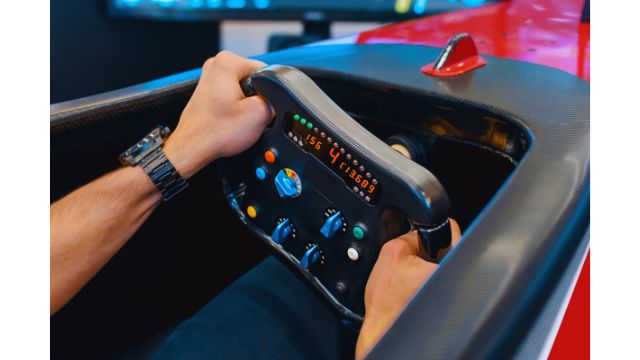Racing simulators have redefined how speed enthusiasts experience the thrill of driving, offering virtual cockpits that rival real-world racetracks. In 2025, these games deliver hyper-realistic physics, stunning visuals, and immersive setups that make every lap feel authentic. Designed for serious racers and hobbyists alike, they replicate the nuances of car handling, track conditions, and race strategy. Whether you’re honing skills for real-world racing or chasing virtual podiums, the right simulator can transport you to the driver’s seat. This article explores the top five racing simulators that feel real, each crafted to deliver heart-pounding, lifelike experiences for speed lovers.
The Magic of Realistic Racing Simulators
What sets racing simulators apart from arcade racers is their commitment to authenticity. These games meticulously model tire grip, aerodynamics, and suspension dynamics, demanding precision in braking, cornering, and throttle control. Advanced graphics, often in 4K with ray-tracing, recreate tracks with laser-scanned accuracy, while VR and motion rigs deepen immersion. In 2025, simulators leverage AI opponents and dynamic weather to mimic real racing conditions. They’re not just games—they’re training tools used by professional drivers and esports athletes. The five simulators highlighted here excel in delivering experiences so vivid, you’ll feel the rumble of the engine and the grip of the asphalt.
1. Assetto Corsa Competizione
Assetto Corsa Competizione, available on PC, PS5, and Xbox Series X/S, is the gold standard for realism in 2025. Focused on the Blancpain GT Series, it features officially licensed GT3 and GT4 cars and laser-scanned tracks like Monza and Silverstone. Its physics engine is a standout, simulating tire wear, fuel consumption, and aerodynamic drag with surgical precision. Dynamic weather and 24-hour race cycles add strategic depth, forcing players to adapt to rain-soaked corners or cooling tracks. The Unreal Engine 4 delivers crisp visuals, and VR support creates a cockpit-like experience. Multiplayer ranked servers foster fierce competition, making this simulator a must for speed lovers craving technical mastery and authenticity.
2. iRacing
iRacing, a PC-exclusive subscription-based simulator, is revered for its uncompromising realism and vibrant online community. In 2025, it remains the choice of professional racers, with laser-scanned tracks and cars ranging from NASCAR to Formula 1. Its physics model is among the most advanced, capturing subtle details like tire temperature and track rubbering. Dynamic track surfaces evolve during races, affecting grip and strategy. The game’s structured multiplayer, with licenses and safety ratings, ensures clean, competitive racing. While its subscription model and steep learning curve may deter casual players, iRacing’s VR compatibility and extensive car roster make it a hyper-realistic haven for dedicated sim racers seeking real-world fidelity.
3. rFactor 2
rFactor 2, available on PC, is a cult favorite among sim racing purists for its unparalleled physics and modding potential. Its tire model, considered the industry benchmark, simulates flex, deformation, and heat with astonishing detail, making every corner a test of skill. The game’s dynamic weather system, including realistic rain and drying tracks, adds complexity to race strategy. While its native graphics are dated, community mods enhance visuals and add modern cars and tracks. In 2025, rFactor 2’s AI has been refined, offering challenging offline races, and its VR support delivers immersive cockpit views. For speed lovers who value physics over polish, this simulator feels like driving a real race car.
4. Automobilista 2
Automobilista 2, a PC-based simulator, offers a diverse racing experience that feels remarkably real. Developed by Reiza Studios, it features a wide range of vehicles—from vintage F1 cars to modern GT racers—and tracks spanning Brazil’s Interlagos to global circuits like Spa. Its physics, built on the Project CARS 2 engine, deliver convincing handling, with detailed feedback on tire grip and suspension. Dynamic weather and time progression create lifelike conditions, while VR support and 4K visuals enhance immersion. The game’s single-player championships and online multiplayer cater to all skill levels. In 2025, regular updates and mod support keep Automobilista 2 fresh, making it a versatile choice for realistic racing.
5. Raceroom Racing Experience
Raceroom Racing Experience, a free-to-play PC simulator with premium content, is an accessible yet authentic option for 2025. Developed by Sector3 Studios, it focuses on GT and touring car racing, with licensed cars and tracks like Nürburgring. Its physics engine captures realistic weight transfer and tire dynamics, offering a tactile driving feel. The game’s sound design, with accurate engine notes and tire screeches, adds to the realism. Dynamic leaderboards and ranked multiplayer ensure competitive races, while VR and triple-monitor support create an immersive setup. Though its free model requires purchases for full content, its quality and affordability make it a top pick for speed lovers seeking real racing thrills.
Why Racing Simulators Feel So Real
The realism of these simulators stems from their obsessive attention to detail. Physics engines model every aspect of a car’s behavior, from brake fade to aerodynamic lift, ensuring authentic responses to driver inputs. Laser-scanned tracks replicate every bump and curb, while dynamic systems like weather and track evolution mirror real-world unpredictability. High-fidelity audio—engine roars, gear shifts, and tire squeals—heightens immersion. VR headsets, force-feedback wheels, and motion rigs bring the cockpit to life, making you feel G-forces and vibrations. These elements, combined with AI that mimics human racers, create experiences so convincing, they’re used by pros like Max Verstappen for training.
The Technology Behind Realistic Simulators
In 2025, racing simulators leverage cutting-edge technology to achieve realism. Next-gen CPUs and GPUs enable 4K visuals with ray-traced lighting, rendering cars and tracks with photorealistic detail. Physics engines, refined over decades, use real-world data from manufacturers to simulate car dynamics. Motion platforms and haptic feedback systems, like those from Fanatec, transmit road textures and crashes to the driver. VR headsets, such as the Valve Index, offer 360-degree cockpit views, while AI algorithms create lifelike opponents. Cloud-based leaderboards and esports integration keep communities engaged. These advancements ensure simulators not only look real but feel like actual racing.
Who Are Racing Simulators For?
Racing simulators appeal to a wide audience, from aspiring racers to casual enthusiasts. Professional drivers use them to practice tracks and refine techniques, as seen with iRacing’s role in motorsport training. Hobbyists enjoy the challenge of mastering complex physics, while esports competitors thrive in online leagues. Beginners can start with forgiving titles like Automobilista 2 before tackling hardcore sims like rFactor 2. In 2025, the genre’s accessibility has grown, with affordable wheels and free-to-play options like Raceroom lowering barriers. For speed lovers craving the intensity of real racing without the costs or risks, these simulators offer an addictive, rewarding escape.
Setting Up Your Sim Racing Rig
To maximize realism, a proper sim racing setup is key. Start with a mid-range wheel and pedal set, like the Logitech G923, offering force feedback for tactile response. A sturdy cockpit or desk mount ensures stability during intense races. For immersion, a 4K monitor or triple-screen setup provides wide field-of-view, while VR headsets like the Oculus Quest 3 deliver cockpit authenticity. High-quality headphones or speakers enhance audio cues, crucial for timing gear shifts. Ensure your PC meets specs—most sims require at least an RTX 3060 GPU and 16GB RAM for smooth performance. Calibrate controls and tweak game settings, like force feedback strength, to match your driving style.
The Community and Esports Scene
Sim racing thrives on passionate communities that share setups, liveries, and strategies. Platforms like RaceDepartment and Reddit host forums where players discuss Assetto Corsa mods or iRacing techniques. YouTube and Twitch creators stream races, offering tutorials for beginners. Esports is booming, with events like the iRacing World Championship attracting pro drivers and sponsors. In 2025, Raceroom’s ranked leaderboards and Automobilista 2’s online leagues foster competitive play. Joining a sim racing discord or league connects you with like-minded speed lovers, turning solo practice into thrilling rivalries. The community’s camaraderie and competition amplify the realism and fun.
Why These Simulators Stand Out
The five simulators—Assetto Corsa Competizione, iRacing, rFactor 2, Automobilista 2, and Raceroom Racing Experience—stand out for their ability to replicate real racing. Assetto Corsa and iRacing offer surgical precision for GT and open-wheel fans, while rFactor 2’s tire model sets a physics benchmark. Automobilista 2’s variety and Raceroom’s accessibility broaden their appeal. Each game’s VR support, dynamic systems, and multiplayer depth create experiences that blur the line between virtual and real. For speed lovers, these simulators deliver the adrenaline of a race car, minus the pit crew, making them essential in 2025.
Tips for Mastering Racing Simulators
Mastering a racing simulator takes practice and patience. Start with a forgiving car, like a GT3 in Assetto Corsa, to learn track layouts and braking points. Use practice modes to perfect lines, referencing real-world racing tutorials on YouTube. Adjust car setups—tire pressure, suspension, or gear ratios—to suit tracks, experimenting in rFactor 2 or Automobilista 2. Study telemetry data in iRacing to identify mistakes. For multiplayer, follow racing etiquette to avoid collisions, starting with Raceroom’s casual servers. Gradually increase AI difficulty or join leagues as skills improve. Consistent practice and community tips will transform you into a virtual racing pro.
The Future of Sim Racing
In 2025, sim racing is poised for growth, with AI-driven opponents becoming more human-like and VR hardware offering higher resolutions. Cloud gaming could make high-end sims accessible on lower-spec PCs, while haptic suits and advanced motion rigs deepen immersion. Esports will expand, with F1 and GT series drawing larger audiences. Modding communities, especially for rFactor 2 and Automobilista 2, will keep older titles relevant with new content. As real-world motorsport embraces sim training, the line between virtual and actual racing will blur further, making simulators a vital part of the speed lover’s world.
Conclusion: Race into Realism
The top five racing simulators of 2025—Assetto Corsa Competizione, iRacing, rFactor 2, Automobilista 2, and Raceroom Racing Experience—offer speed lovers an unmatched taste of real racing. Their lifelike physics, stunning visuals, and immersive features make every lap feel like a pro event. Whether you’re battling GT3 cars at Monza or chasing F1 glory, these games deliver adrenaline and precision. Build your rig, join the community, and dive into these virtual cockpits to experience the rush of the racetrack. For those who live for speed, these simulators are your ticket to a thrilling, realistic ride.





